Achievement of Curriculum for Excellence (CfE) Levels 2015-16
This contains the results of the achievement of curriculum for excellence (CfE) levels data collection.
Achievement of Curriculum for Excellence (CfE) Levels 2015/16
Experimental Statistics - Data under development
13 th December 2016
These statistics are currently being developed and have been published to involve users and stakeholders in their development, and to build in quality and understanding at an early stage.
The new annual Achievement of Curriculum for Excellence (CfE) Levels Return collects data from all publicly funded schools, and gathers information for all pupils in Primary 1, Primary 4, Primary 7 and Secondary 3 and for all pupils based in special schools/units.
This return measures national performance in aspects of literacy (i.e. reading, writing, and listening and talking) and numeracy, and reports on the proportion of pupils who have achieved the expected CfE level, based on teacher professional judgements, relevant to their stage.
The information was based on teacher professional judgements as at June 2016. This publication provides detailed analysis on aggregated national and local authority level results for each stage.
For each stage, the percentage of pupils reaching the expected CfE levels is shown below (please see section 1.2 for more detail on CfE levels).
Full results are available from http://www.gov.scot/stats/bulletins/01253
All figures are for Achievement of Curriculum for Excellence (CfE) Levels in reading, writing and listening and talking in the English language unless otherwise specified (Achievement of CfE Level in Gàidhlig can be found in Chapter 7).
Key Findings
- The proportion of pupils achieving the CfE level relevant for their stage is generally highest for listening and talking and lowest for writing across all primary and secondary stages.
- The proportion of pupils achieving the CfE level relevant for their stage falls throughout the primary stages.
- The proportion of S3 pupils achieving CfE Third Level and better is between 84 and 87 per cent for each curriculum area (i.e. reading, writing, listening and talking, and numeracy).
- For each curriculum area, a higher proportion of pupils living in the least deprived areas achieve the CfE level relevant to their stage compared to pupils living in the most deprived areas (i.e. there is an attainment 'gap').
- For each curriculum area, the percentage point difference between the proportion of pupils who live in the least deprived areas compared with pupils who live in the most deprived areas (i.e. the attainment 'gap') achieving the CfE level relevant to their stage widens throughout the primary stages.
- For each curriculum area, the percentage point difference between the proportion of S3 pupils who live in the least deprived areas compared with S3 pupils who live in the most deprived areas (i.e. the attainment 'gap') achieving CfE Third Level and better narrows to a similar magnitude to those seen in Primary 1. However, the attainment 'gap' for S3 pupils achieving CfE Fourth Level is generally similar to that seen in Primary 7 for reading and writing, but widens further for listening and talking, and numeracy.
Percentage of primary pupils achieving expected CfE Levels, 2015/16
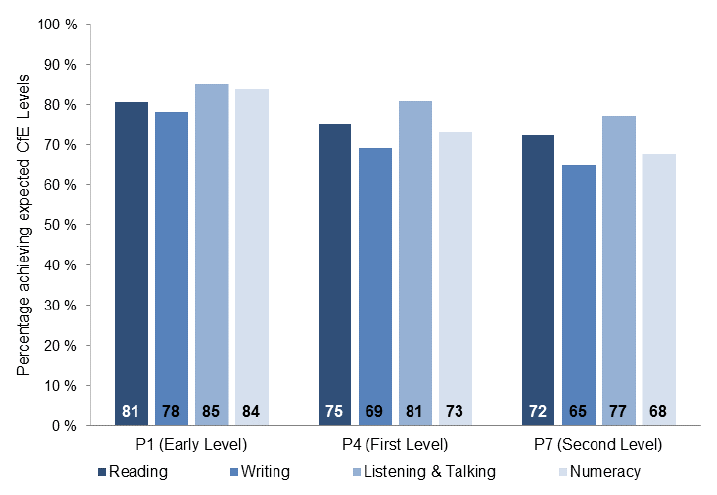
The proportion of P1 pupils achieving Early Level:
- 81 per cent in reading
- 78 per cent in writing
- 85 per cent in listening and talking
- 84 per cent in numeracy
The proportion of P4 pupils achieving First Level:
- 75 per cent in reading
- 69 per cent in writing
- 81 per cent in listening and talking
- 73 per cent in numeracy
The proportion of P7 pupils achieving Second Level:
- 72 per cent in reading
- 65 per cent in writing
- 77 per cent in listening and talking
- 68 per cent in numeracy
Percentage of S3 pupils achieving CfE Levels, 2015/16
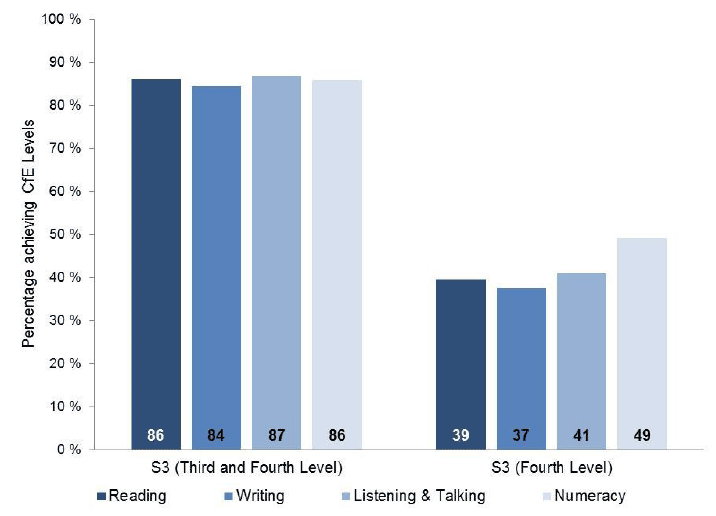
The proportion of S3 pupils achieving Third Level and better:
- 86 per cent in reading
- 84 per cent in writing
- 87 per cent in listening and talking
- 86 per cent in numeracy
The proportion of S3 pupils achieving Fourth Level:
- 39 per cent in reading
- 37 per cent in writing
- 41 per cent in listening and talking
- 49 per cent in numeracy
Percentage of P1 pupils achieving Early Level, by SIMD [1] ,2015/16
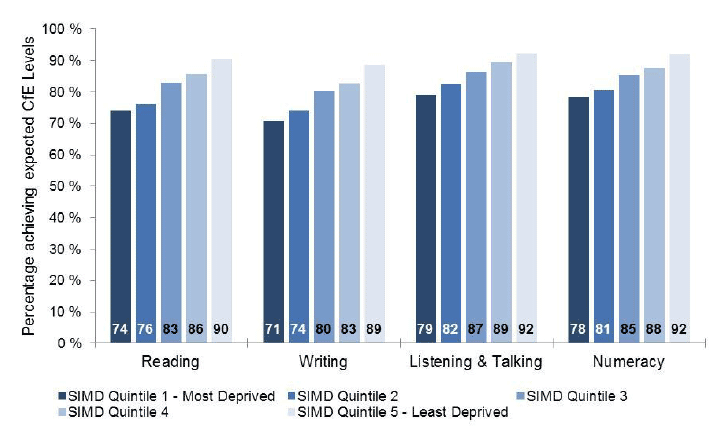
- 74 per cent of P1 pupils living in the most deprived quintile (fifth) achieved Early Level in reading compared with 90 per cent of P1 pupils living in the least deprived quintile.
- 71 per cent of P1 pupils living in the most deprived quintile achieved Early Level in writing compared with 89 per cent of P1 pupils living in the least deprived quintile.
- 79 per cent of P1 pupils living in the most deprived quintile achieved Early Level in listening and talking compared with 92 per cent of P1 pupils living in the least deprived quintile.
- 78 per cent of P1 pupils living in the most deprived quintile achieved Early Level in numeracy compared with 92 per cent of P1 pupils living in the least deprived quintile.
Percentage of P4 pupils achieving First Level, by SIMD, 2015/16
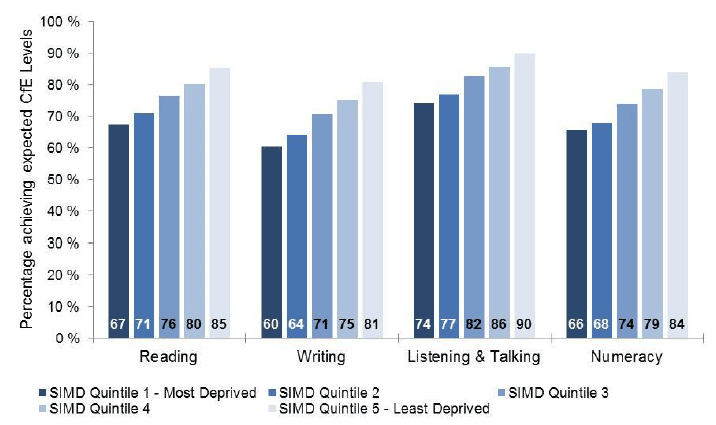
- 67 per cent of P4 pupils living in the most deprived quintile achieved First Level in reading compared with 85 per cent of P4 pupils living in the least deprived quintile.
- 60 per cent of P4 pupils living in the most deprived quintile achieved First Level in writing compared with 81 per cent of P4 pupils living in the least deprived quintile.
- 74 per cent of P4 pupils living in the most deprived quintile achieved First Level in listening and talking compared with 90 per cent of P4 pupils living in the least deprived quintile.
- 66 per cent of P4 pupils living in the most deprived quintile achieved First Level in numeracy compared with 84 per cent of P4 pupils living in the least deprived quintile.
Percentage of P7 pupils achieving Second Level, by SIMD, 2015/16
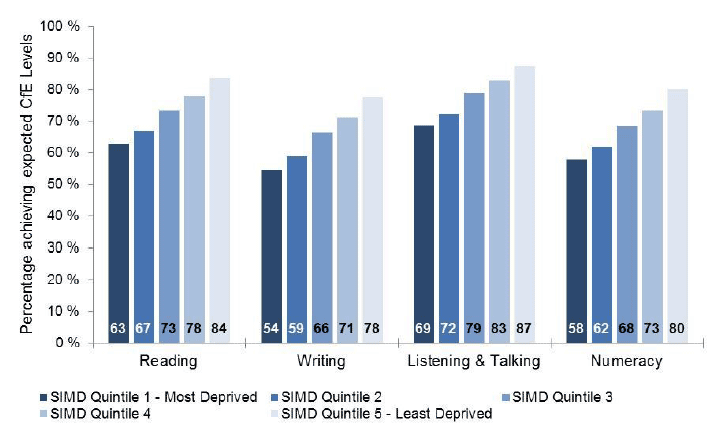
- 63 per cent of P7 pupils living in the most deprived quintile achieved Second Level in reading compared with 84 per cent of P7 pupils living in the least deprived quintile.
- 54 per cent of P7 pupils living in the most deprived quintile achieved Second Level in writing compared with 78 per cent of P7 pupils living in the least deprived quintile.
- 69 per cent of P7 pupils living in the most deprived quintile achieved Second Level in listening and talking compared with 87 per cent of P7 pupils living in the least deprived quintile.
- 58 per cent of P7 pupils living in the most deprived quintile achieved Second Level in numeracy compared with 80 per cent of P7 pupils living in the least deprived quintile.
Percentage of S3 pupils achieving Third and Fourth Levels, by SIMD, 2015/16
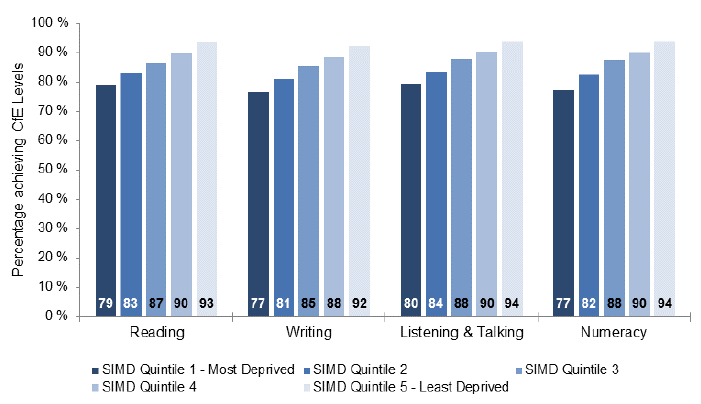
- 79 per cent of S3 pupils living in the most deprived quintile achieved Third Level or better in reading compared with 93 per cent of S3 pupils living in the least deprived quintile.
- 77 per cent of S3 pupils living in the most deprived quintile achieved Third Level or betterin writing compared with 92 per cent of S3 pupils living in the least deprived quintile.
- 80 per cent of S3 pupils living in the most deprived quintile achieved Third Level or betterin listening and talking compared with 94 per cent of S3 pupils living in the least deprived quintile.
- 77 per cent of S3 pupils living in the most deprived quintile achieved ThThird Level or better in numeracy compared with 94 per cent of S3 pupils living in the least deprived quintile.
Percentage of S3 pupils achieving Fourth Level by SIMD, 2015/16
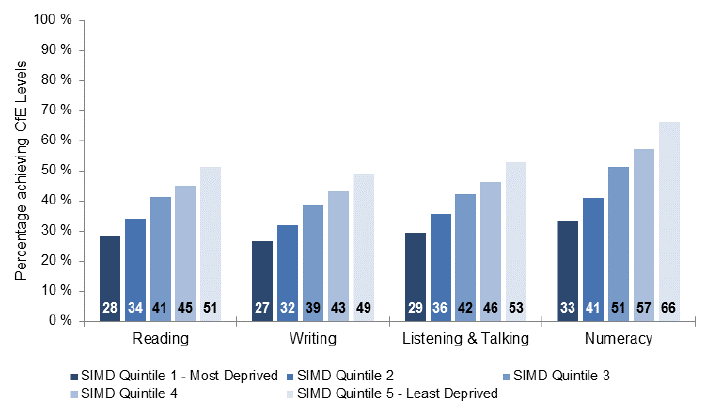
- 28 per cent of S3 pupils living in the most deprived quintile achieved Fourth Level in reading compared with 51 per cent of S3 pupils living in the least deprived quintile.
- 27 per cent of S3 pupils living in the most deprived quintile achieved Fourth Level in writing compared with 49 per cent of S3 pupils living in the least deprived quintile.
- 29 per cent of S3 pupils living in the most deprived quintile achieved Fourth Level in listening and talking compared with 53 per cent of S3 pupils living in the least deprived quintile.
- 33 per cent of S3 pupils living in the most deprived quintile achieved Fourth Level in numeracy compared with 66 per cent of S3 pupils living in the least deprived quintile.
Contact
There is a problem
Thanks for your feedback